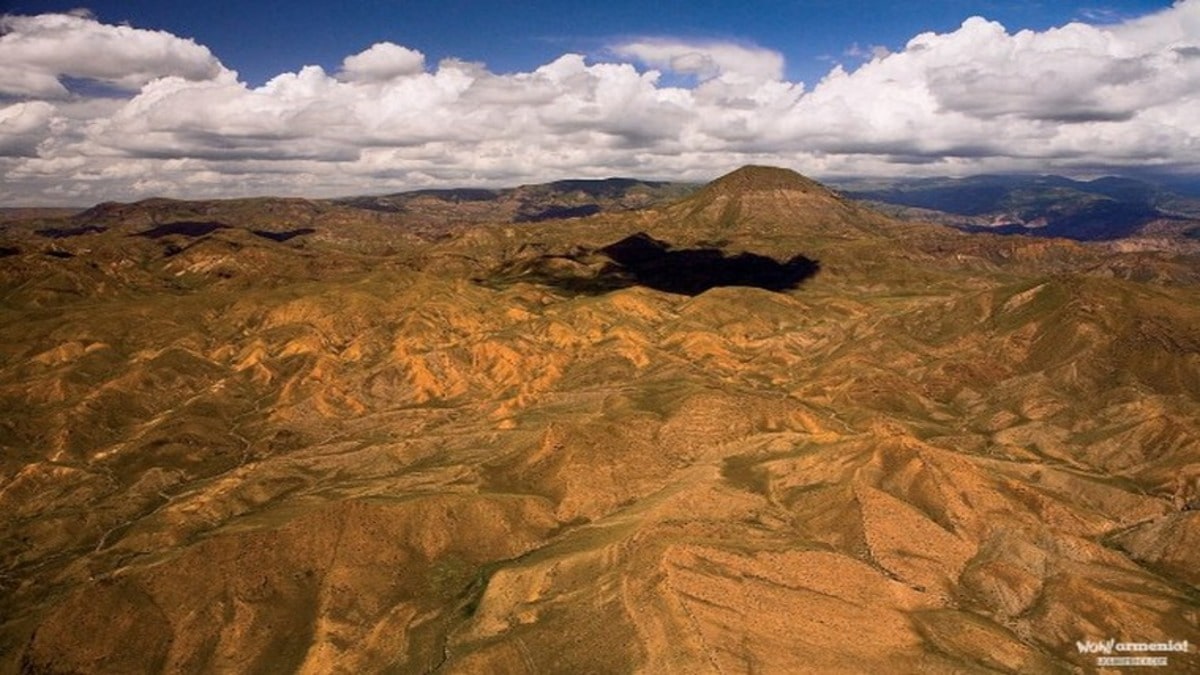
The great Russian geneticist, Academician N. Vavilov, regarded ancient Armenia as the origin (or “hearth”) of many cultivated plants, especially cereals. The topic of ancient cereal ancestors is widely covered in the works of N.I. Vavilov.
In Armenia, besides the progenitors of cereals, some relict plants of Armenian flora also draw significant interest from specialists. They have grown for millions of years on the tertiary red clays stretching from the Djervej Gorge (near Yerevan) to the ancient village of Marmarashen. These clays are rich in iron compounds and contain manganese oxide.
The vegetation formation that developed on this soil is well known to science as ephemero-galantious. According to the firm conviction and statement of Academician N.I. Vavilov, this unique ephemero-galantious formation includes a whole range of the oldest species of wild wheat, from which all types of cultivated wheat on earth originated!
The Armenians had a significant influence on the development of agricultural culture, “metallurgy… and artificial irrigation” on other peoples. Historian-researcher A. Varshavsky states, “One of the contemporary researchers, Professor Shahermayr, believes that agriculture in Crete was greatly aided by immigrants from Syria (ancient state Aram/Aramea; S.N.), as well as from Western Armenia (they call this place – Anatolia ancient Armenian cities, Sevastia, Armeniak/amsheny) – at that time the Hittites lived there (representatives of the Armenoid race, ‘people related to the ancient Armenians’; in Georgian sources, Armenians are referred to as ‘sam-KHET-ys’).”
He further emphasizes that also “from Cilicia.” Historian S. Koul (in the book “The Neolithic Revolution”), citing many sources, writes that Armenia is rightfully considered the birthplace of modern cereal plants. Ancient Armenia appears as a special country (according to some sources, Armenia was Eden), where in several regions, the simplest wheat (known as “single-grain”) was initially found. Z. Vorontsova notes: “The main findings of archaeologists are wheat, rice….
The oldest, and apparently ancestral for all existing species of this grain, are wild single-grain wheats: Beotian (ancient biblical kingdom AYRARAT; S.N.), widespread in South-West Asia.” Also, in ancient Armenia, wild two-rowed barley, rye, millet, and its varieties were used in brewing, cosmetics, and more.
For example, many ancient Armenian sources mention a variety of some grain called “korek,” often used in the healing Armenian culture of nutrition. Scientists have found that this is a variety of archaic millet – so-called “sorghum.” The list of grains also included amaranth – a valuable cereal crop, characterized by high calorie content and micronutrients.
Both the flora and fauna of Armenia are unique. (1) In Armenia’s flora, many unique endemic plants represent some of the rarest botanical relicts of the Tertiary period (firmly entrenched in our daily lives). They are of great interest to specialists. Here are just some of them:
- Berry yew (taxus bassata L.);
- Cultivated nigella (Nidella cativa);
- Nigella (Nidella oxypetava);
- Euphorbia chamaesyce (Euphordia chamaesyce);
- Horned poppy (“motsok” – ancient Arm.) or “Arm. bush” (Claucium corniculatum);
- Mountain chicory (Cichoriym dlandulosum Boiss et Hoh);
- Ironwort (Sideritis montana);
- Astragalus (Astragalus);
- Fenugreek (Tridobella);
- Armenian savory (“(h)ay-urts”, Thumus kotshyanus Boiss. et Hoh.), this plant is prone to polymorphism in new growing places;
- So-called “amaspur” (one of the species of Lychnis floscuculi and L.coricaea Moench) and many others.
“Amaspur” in Armenian sources as “Hamaspyur” – is a semi-legendary plant (including mentions in poetry). (2) It was highly valued by many ancient and medieval scientists and physicians, alchemists, and various Kabbalists – Sharif, Pittak of Mytilene, Pythagoras, Giovanni de Mirandola/Pico, Moses ben-Maimon, Maria the Alchemist, Philippus Aureolus Theophrastus Bombast/Paracelsus, Michel Nostradamus, the so-called “Prague Rebbe,” Robert Fludd, Jacques Charpentier, Abu Ali ibn-Sina (Avicenna), and others.
Many types of Armenian flora were also highly valued – all types of bitter wormwood, Ararat calamus, immortelle (“antaram”/”unfading”), etc. In Armenia’s flora, there are about 12 types of immortelle alone! Among the people, immortelle was called “cat’s paw” (“kugi katu” – ancient Arm.). There are also known several types of archaic Armenian calamus.
For a long time, it was believed that the plant calamus was irretrievably lost, but in the 20th century, it was miraculously discovered in the vicinity of St. Etchmiadzin! Also, the ancient Armenian endemics – sea buckthorn and so-called “Greek” walnut (“chhkuz” – ancient Arm.; “argiz” – Arabized form; “Juglans regia L.” – Latin). “The culture of the walnut has been cultivated in Armenia since ancient times, where wild species and feral cultivated varieties are found…
The possibility of migration of the Armenian term to other languages is not excluded. The apricot is also an ancient Armenian endemic (“armany” – ancient Sumerian, “armeniaca vulgaris” – Latin). V. Pokhlebkin noted that the apricot was exported by order of Alexander the Great from Armenia and spread during the Hellenistic period throughout the Near and Middle East, Southern Europe, and the Mediterranean. Later, it was introduced into Southeast Asia. One of its varieties is the so-called “… zherdela – a small sweet apricot.”
The most ancient, Sen-aar/Sumerian name of the apricot, “Armenica,” reappeared in modern etymological usage through the Swedish scientist Carl Linnaeus. The list could go on for a long time. And one of the “leading contemporary Armenian botanist-systematists E.Gabrielyan” considers “Armenia, from the standpoint of floristic findings, to be truly a magical country.”
Natalya Sobol From the unpublished “About Armenian history, food, and not only…”
Translated by Vigen Avetisyan
COMMENTS:
(1) The FAUNA of Armenia, just like the flora, is truly unique, from mammals to insects. For example, the ancient “Armenian yellow bee species,” which was domesticated in Armenia and Armenian states of Asia Minor 4,000 years BC (according to K.Frisi, I.Khalifman, N.Ioyrish, E.Bertran, V.Nekrasov, L.Potekhin, etc.). Among such rarities is also a mammal – the “Armenian mouflon”… found only in Armenia, but occasionally seen in Northern Iran and Turkish Armenia. Ananyan V. “On the shore of Sevan,” p.196.
(2) AMASPYUR – in ancient Armenian sources “hamaspyur,” a semi-legendary plant, almost equal in properties to the famous “mandrake root.” This “flower, possessing, according to folklore, miraculous properties” was worth its weight in gold. It was believed that if a “person … eats it or rubs it on their body, they acquire all kinds of knowledge and the ability to speak all languages.” This plant is mentioned in Armenian legends and even in ritual songs from the early medieval period, such as the words (“Wedding Song”): … “What will I give to the king, what resembles him … Is it not gamaspyur, that does not wither …?” “Armenian Medieval …”, p.106,361.
SOURCES:
Amasiatsi A. “Useless for the Uneducated”, p.49,135, 216,294,522-526,572,587,613,696. Ananyan V. “On the Shore of Sevan”, p.196. “Armenian Medieval …”, p.106,361. Archimandrite Nikifor “Biblical Encyclopedia”, 1891. Vorontsova Z. “Amazing Plants”, postcards. Grigoryan E. “Armenian Highlands …”, article. Koul S. “Neolithic Revolution.” Xenophon “Anabasis” IV-7,25; V-31. Mellaart J. “Ancient Civilizations of the East”, p.3-10. Piotrovsky B. “Karmir Blur.” Pokhlebkin V. “Culinary Dictionary”, p.17. The same “National Cuisine …”, p.300-301. Sagokosov M. “On the Subject of Beverages”, p.8,13,19. Respondents: Gabrielyan Gabriel and Violetta. Ter-Muradyan Alla.


